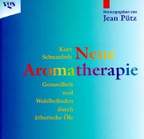Kurt Schnaubelt
Enter Kurt Schnaubelt's approach to life, the universe, and aromatherapy appeals to me. His excellent conferences bring together presenters from many fields and modalities, creating a bigger picture for aromatherapy within the context of holistic health. During his intensive course he explained the science of aromatherapy in an accessible way, never getting stuck in rigid paradigms.
Schanubelt lets nature and the intention of the products play their part, promoting the view that flexibility is key when dealing with aromatics.As a chemist he knows better than most the importance of working from an informed psition, and as a humanist he honors all of life and what it means to be alive. As he says in his 1999 book Medical Aromatherapy "It is the most blatant admission of hubris, that scientific proof amounts to the act of creation."
With more science under my belt I finally understood why bay leaf hydrosol clears swollen lymph nodes in breast tissue and why green myrtle hydrosol can be put into the eyes. The connection between homeopathy and hydrosols also became clearer.
Hydrosols can be seen as microdoses of oil, and if used in the manner prescribed by Grosjean and others, this microdose is further diluted in water. In Homeopathy , the more you dilute, the stronger the remedy. When you drink a litre of water containing hydrosol over the course of a day, you are taking multiple microdoses of you "remedy".
In homeopathy, multiple doses at frequent intervals are the most powerful and potent way to take remedies. And as Schnaubelt points out, a microdose can achieve the same thing as a megadose in the appropriate situation.There are many people and hundreds of events that have influenced my learning path and direction in the world of aromatherapy, but in the context of hydrosols, my encounters with Grosjean, Penoel, Franchomme, and Schnaubelt have most dramatically altered my thinking.
Reference: Hydrosols The next Aromatherapy: Suzanne Catty
Articles - Most Read
- Home
- What are Hydrosols
- What are Hydrosols-2
- The Monographs
- How to Make a Hydrosol
- Distilled or Extracted Specifically For Therapeutic Use - 3
- Table of Common Latin Names and pH Values - F - O
- Kurt Schnaubelt
- What isn't a Hydrosol?
- Table of Common Latin Names and pH Values - P - S
- Wholly Water!
- Blue Babies
- Supply and Demands
- Mature Skin
- Recipes Alpha F
- Hydrosols In The Marketplace
- Hemorrhoids
- Chemicals: Friends or Foes?
- Nelly GrosJean
- Water as Medicine
- The Educated Consumer
- Influences
- Genitically Modified Plants
- Water Quality
Articles-latest
- Daucus carota/Wild Carrot Seed - pH 3.8-4.0
- Cupressus sempervirens/ Cypress-pH3.5-3.7
- Coriandrum sativum/Coriander Herb-and-Seed
- Comptonia peregrinal/Sweet Fern- pH 3.8
- Citrus clementine (fe) Clementine Petitgrain- pH 4.3-4.4
- Citrus aurantium var. amara (flos) /Neroli Orange Blossom-pH3.8-4.5
- Cistus ladaniferus/Rock Rose-pH 2.9-3.1
- Cinnamomum zeylanicum (ec) Cinnamon Bark-pH3.3
- Chamaemelum nobile/Roman Chamomile - pH 3.0-3,3
- Centaurea cyanus/Cornflower/Bachelor's Button-pH 4.7-5.0
- Cedrus atlantical/Cedarwood/Atlas Cedar-pH 4.1- 4.2
- Hydrosols -The PH - Anomalies
- Hydrosols- Establishing Shelf Life and Stability
- Boswellia carterii/FRANKINCENSE
- Asarum canadense/ Wild Ginger/Canadian Ginger
- Artemesia vulgaris / Artemesia
- ARTEMESIA DRACUNCULUS - TARRAGON
- Angelica archangelica / Angelica Root - Hydrosols
- The Key, or More Correctly, the pH - 2 - Hydrosols
- The Key, or More Correctly, the pH-Hydrosols
- The Hard pHacts - Hydrosols
- Calamus Root/Sweet Flag - ACORUS CALAMUS
- Yarrow - Achillea millefolium - Hydrosols
- Balsam Fir - Abies balsamea - Hydrosols


